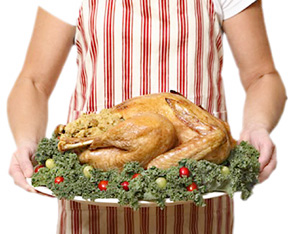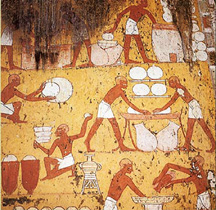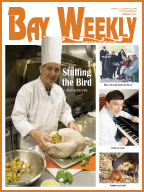Stuffing the Bird

An American Rite
by Margaret Tearman
Nary a traditional American Thanksgiving dinner is complete without a roasted turkey — stuffed up to its neck with bread stuffing. Sure, cranberries in some form or another are usually present, as are sweet potatoes, mashed potatoes and, at least in our region, sauerkraut and brats. But Thanksgiving turkey dinner wouldn’t be the real McCoy without stuffing.
Turkey stuffing is a uniquely American holiday food, albeit one with regional incarnations. In the South, cornbread stuffing is a local favorite. Farther west, spicy Mexican chorizo sausage is added. On the Pacific coast, sourdough stuffing is all the rage. In the Northeast, it’s all about the oysters. Chestnut stuffing, especially in the Appalachian region where the trees were once abundant, is quintessentially American.
Regardless of what is added, the stuff used to fill the turkey has one common ingredient: bread.
The Revered Ingredient
The humble loaf has a storied life way beyond our borders.
The staff of life can be traced to ancient Mesopotamia and Egypt where wheat was grown and chewed in its natural form. Over time, early bakers learned to grind the grain into a paste. Cooked over a fire, the paste hardened into a flat bread with a long storage life. Around 1000bc, yeast was added to the paste, and leavened, or raised, bread was born.
 Over the centuries, bread has risen to prominence in cultures worldwide, becoming the center of social rituals and religious rites.
Over the centuries, bread has risen to prominence in cultures worldwide, becoming the center of social rituals and religious rites.
The many variations of bread reflect the cultures of the world: The French — who give us the word companion, meaning one with whom you break bread — have brioche and baguettes, Russians have rye, Jews challah, Germans pumpernickel, Italian focaccia and Irish soda bread. Armenians love their lavash, and Arabians and Indians both eat pita just as the Mexicans do their tortillas.
As a religious symbol, bread dates at least to ancient Egypt, where threshing grain was a holy rite. A Sumerian creation story says the first bread was baked in a shrine.
Bread figures prominently in the Bible, where it is mentioned about 250 times. Manna, or Essene bread, is believed to be a gift from God to feed the ancient Israelites. Challah, meaning dough offering, is given as a gift back to God. Bethlehem means House of Bread, and Jesus referred to himself as “the bread of life.”
The term breaking bread occurs often in the New Testament, where it sometimes means to share bread, other times to give food to those without. Central to religions based on the New Testament is the sacrament of communion, when bread is transformed by consecration into the body of Christ to be shared and eaten by the congregation.
During Passover, Jewish homes forbid any leavened products in remembrance of their historic flight from Egypt. In their haste to leave, there was not time for the bread to rise, so matzah, an unleavened bread, is eaten as part of the Passover ritual.
Muslims bake bread for the feast of Id al-Fitr, ending the fasting of Ramadan.
Bread’s cultural role is just as heavy. Often, baking bread is symbolic of procreation. Loading the oven, baking the bread and unloading the oven represents copulation, pregnancy and childbirth and is where the saying she’s got a bun in the oven originated.
In Jakarta, the native Betawi believe the crocodile represents loyalty and long life. Two pieces of sweetened bread in the shape of crocodiles are a must at every Betawi traditional wedding ceremony. In Russia, people give newlyweds bread and salt as a symbol of health and prosperity.
In the Ukraine, the tradition extends to guests, who are presented a circular bread, klib, and a mold of salt, sil, on an embroidered ceremonial cloth. The right thing for the hosts to say is With this bread and salt we greet you. Welcome: Vitayemo! The bread represents hospitality, and the salt symbolizes eternal friendship because it never loses its taste.
In Mexico, Pan del Muerto, circular and decorated with a cross of bones covered with sugar, is offered to the deceased as a peace offering at Los Dias de los Muertos.
Among the other powers of bread: The Hittites believed bread protected their soldiers from impotence and that leavened bread would ward off epidemics. In the Middle Ages, Belgians believed bread kneaded on Christmas Eve protected their homes against lightning.
In America, the great melting pot where all these traditions come together, we give bread — which, with dough, is slang for money — a sacred place at the Thanksgiving table.
Melting Pot Stuffing
by Helen Perry
This recipe came about as a result of my mother and my mother-in-law helping in the kitchen to prepare the Thanksgiving feast. I had my ideas. Mainly I liked sausage and cornbread with herbs added. My mother-in-law wanted the stuffing prepared separately, and we had just gotten the first microwave. My mother insisted that every self-respecting stuffing should have a shredded tart apple and that fall nut, the chestnut.
Over several years the recipe evolved.
5-7 ounce canned roasted chestnuts
3 cups cornbread stuffing
1 Granny Smith apple, shredded
2 cups broth
1⁄2 pound sausage (I prefer Polish sausage)
3⁄4 cup of chopped onion
2 sticks of chopped celery
2 tablespoons of chopped parsley
2 tablespoons of chopped sage
1⁄2 cup of olive oil
2 eggs, slightly beaten
Sauté the onions and celery until tender, add the sausage and brown. Set aside. Combine the cornbread stuffing, apple, broth, olive oil, parsley, sage, chestnuts and eggs. Add the sausage cornbread mixture. Mix. Microwave for 10 minutes. Stuff.
Break, Never Cut, the Bread
by Margaret Tearman
In my childhood home, bread stuffing was a tradition sprinkled with superstition. My mother’s Thanksgiving dinner always included sage bread stuffing from her Better Homes and Gardens cookbook. This recipe called for a minimum of four loaves of day-old white bread, torn into one-inch pieces.
To meet the day-old requirement, Mom slit open the plastic wrappers — reminders that the best thing since sliced bread refers back to Wonder Bread’s wonderful invention in the 1930s — and let the loaves sit on the kitchen counter for 24 hours.
The real work began on Thanksgiving eve. Mom would sit my father and me down at the table, the big black-and-white speckled roasting pan between us, and give us each two loaves of bread. Here is where it got curious. Mom would not allow us to cut the bread with a knife. It had to be torn by hand. She believed that using a knife would ruin the stuffing. “It gives it a funny metallic taste,” she would sniff.
While we tore, and griped about the tedium, she stood at the kitchen counter happily chopping celery and onions. She didn’t have a problem with knives touching vegetables.
The hand-torn bread, heaped in the old roasting pan, would sit overnight to achieve the perfect state of staleness.
On Thanksgiving morning, the bread was hand-tossed with the remaining ingredients. My dad would stuff the bird, by hand, and the remaining stuffing would be cooked separately in a casserole. A spoon was allowed to touch the stuffing only as it was being served at the table.
Think what you will about my mother’s obsession, but her bread stuffing was always the star of our Thanksgiving feast.
In the years since her death, I’ve hosted many Thanksgiving dinners. For my stuffing, I use the same recipe. Each time, I have been tempted to skip the handwork and use a knife. But I have never been able to bring myself to do it, fearing the wrath of some unknown bread deity will be unleashed upon my household.
My First Turkey
by Sandra Lee Anderson
The problem with being a teenager is that you’re expected to take responsibility. That lesson apparently went for my dad, too. Mom had started selling real estate, and was particularly vexed in the evenings when she would come home from showing a house to find that we had done nothing to prepare dinner except wait for her.
 Dad and I were still learning our lesson when Thanksgiving arrived. Mom prepared what she could the night before, including the pumpkin pie and cranberry sour cream salad. In the morning she got up early, tore up some bread and used the bread stuffing recipe from her Lilly Wallace New American Cookbook (1944):
Dad and I were still learning our lesson when Thanksgiving arrived. Mom prepared what she could the night before, including the pumpkin pie and cranberry sour cream salad. In the morning she got up early, tore up some bread and used the bread stuffing recipe from her Lilly Wallace New American Cookbook (1944):
2 cups bread crumbs
1⁄2 cup melted butter
1⁄2 cup celery, cut fine
1 small onion, chopped
Sauté the celery and onion in the fat until soft and add to the bread crumbs. Mix well.
She stuffed the bird, gave us instructions and went out the door to meet a client. The rest was up to Dad and me. My sister, six years younger, got through Scott-free.
My dad only had one workable arm due to polio, so he and I made sure I used the baster every 30 minutes to squirt the turkey with juice and butter from the bottom of the pan.
After a long day, Mom returned to find nothing else prepared, though I had set the table. The deep brown turkey was long overdue. She sighed, spooned out the dressing, opened a can of beans, turned out the cranberry mold and told me to open the black olives, pickles and whole cranberries and to cut some celery and carrot sticks. Among her other regrets about this dinner, she hadn’t been able to make her traditional butterhorn rolls.
Yet the family story that endured was that this turkey, whose joints fell apart, was the most juicy and delicious of all.
How a Pro Makes Stuffing

Chef Tom McReynolds’ Basic Turkey Stuffing
8-10 cups dry bread crumbs or stuffing mix
1⁄2 cup chopped celer
1⁄2 cup chopped onio
3 cups chicken stock or 3 chicken bouillon cubes dissolved in 3 cups of water
2 tsp. poultry seasoning
2 tsp. dried sage
Dash black pepper
1 stick butter or 1⁄2 stick butter and 1⁄2 stick margarine
Lightly sauté onion and celery for 3 minutes. Do not brown. Add chicken stock and seasonings. Simmer for 6-8 minutes.
Place bread crumbs or stuffing mix in a large bowl. Stir the stock so that the celery and onion do not settle on the bottom. Pour two-thirds of the broth over the bread or mix. Mix well. Add more broth as needed, but only enough to bind the stuffing. Better to have too dry than too wet as the stuffing will absorb moisture from the turkey. Mix well. Let stand for 5 minutes. Check for moisture. Taste for seasoning.
Stuff and enjoy!
Tom McReynolds is executive chef at Herrington on the Bay
![]()



 Over the centuries, bread has risen to prominence in cultures worldwide, becoming the center of social rituals and religious rites.
Over the centuries, bread has risen to prominence in cultures worldwide, becoming the center of social rituals and religious rites. Dad and I were still learning our lesson when Thanksgiving arrived. Mom prepared what she could the night before, including the pumpkin pie and cranberry sour cream salad. In the morning she got up early, tore up some bread and used the bread stuffing recipe from her Lilly Wallace New American Cookbook (1944):
Dad and I were still learning our lesson when Thanksgiving arrived. Mom prepared what she could the night before, including the pumpkin pie and cranberry sour cream salad. In the morning she got up early, tore up some bread and used the bread stuffing recipe from her Lilly Wallace New American Cookbook (1944):
